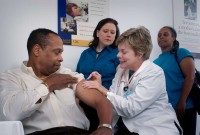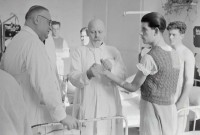- Home
- Business Processes
- Industry Knowledge
- Aerospace Industry
- Automotive Industry
- Banking Domain
- BFSI Industry
- Consumer/ FMCG Industry
- Chemicals Industry
- Engineering & Construction
- Energy Industry
- Education Domain
- Finance Domain
- Hospitality Domain
- Healthcare Industry
- Insurance Domain
- Retail Industry
- Travel and Tourism Domain
- Telecom Industry
- Leadership Skills
- eLearning
- Home
- Industry Knowledge
- Healthcare Industry
- Urgent Care Centers
Urgent Care Centers
This article provides insightful industry analysis and research into the Urgent Care Centers industry. This article discusses the definition, key industry products, and activities along with major industry trends. Understand the revenue model, a brief history of trends during the current century, and key challenges currently being faced by the Urgent Care Centers industry.
What are Urgent Care Centers?
Urgent care is the delivery of ambulatory care in a facility dedicated to the delivery of medical care outside of a hospital emergency department, usually on an unscheduled, walk-in basis. Urgent care centers are primarily used to treat patients who have an injury or illness that requires immediate care but is not serious enough to warrant a visit to an emergency department. Urgent care centers provide walk-in, extended hour access for acute illness and injury care that is either beyond the scope or availability of the typical primary care practice or retail clinic. Often urgent care centers are not open on a continuous basis, unlike a hospital emergency department that would be open at all times. Urgent care centers are distinguished from other similar types of ambulatory healthcare centers, such as emergency departments, and walk-in primary care centers by the scope of illness treated and facilities available on-site.
What is the business model of Urgent Care Centers?
They are typically staffed with physicians, and may also have physician assistants, nurses, nurse practitioners, medical assistants, and radiology technicians working with patients. They typically open between 8 and 9 am, and close between 7 and 9 pm on the weekdays (and somewhat earlier on weekends).
Urgent care centers are usually located in freestanding buildings, and the majority of centers are independently owned by physicians or groups of physicians. About 25 percent are owned by a hospital system – and most of those are located off the main hospital campus. Urgent care centers may also provide other healthcare services in addition to treating common and acute illness and injury. Many centers provide occupational medicine services, travel medicine services, and sports and school physicals.
What is the Urgent Care Centers Industry?
This industry includes facilities that deliver medical care on an unscheduled, walk-in basis. Urgent care centers are primarily used to treat patients who have an injury or illness that requires immediate care but is not serious enough to warrant emergency room care. There are over 8,700 urgent care centers in the US, approximately 4,500 of which are fully-fledged centers that would meet the criteria for a Certified Urgent Care center.
Urgent Care Centers Industry Products:
- Diagnostic testing and laboratory services
- Medication dispensing
- Minor procedures
- Physician Specialties
- Family Physicians
- Emergency Medicine
- Internal Medicine
Urgent Care Centers Industry Activities:
- Treating common and acute illness and injury
- Occupational medicine services
- Travel medicine services
- Sports and school physicals
- Diagnose general symptoms
- Fever Treatment
- Upper respiratory infections treatment
- Sprains and strains treatment
- Lacerations, contusions, and back pain treatment
- Fractures treatment
- Provide IV fluids,
- Provide x-ray services & lab processing onsite
- Provide routine blood tests and other diagnostic laboratory procedures
- Provide pre-packaged prescription services
- Provide treatment for minor traumas such as broken bones and lacerations
Trends and Challenges for Urgent Care Centers Industry:
The Urgent Care Centers industry represents one of the fastest-growing segments of the American healthcare system. Given below are some key trends of this industry:
- Approximately 8,700 centers in the U.S.
- 65% of centers have at least one physician on-site at all times
- Rising demand due to primary care centers reaching capacity
- Rising wait times for both primary- and emergency-care providers
- The Patient Protection and Affordable Care Act
- Cost-saving initiatives
Related Links
You May Also Like
-
General Medical & Surgical Hospitals
This article provides insightful industry analysis and research into the general medical and surgical hospitals industry. This article contains the definition, key industry products, and activities and discusses in brief major industry trends.
-
Mental health and residential developmental handicap facilities
This article provides insightful industry analysis and research into the Mental health and residential developmental handicap facilities industry. This article discusses the definition, key industry products, and activities along with major industry trends. Understand the revenue model, a brief history of trends during the current century, and key challenges currently being faced by the Mental health and residential developmental handicap facilities industry.
-
This article provides insightful industry analysis and research into the specialty hospital industry. This article discusses the definition, key industry products, and activities along with major industry trends. Understand the revenue model, a brief history of trends during the current century, and key challenges currently being faced by the specialty hospital industry.
-
This article provides insightful industry analysis and research into the In-Home Senior Care industry. This article discusses the definition, key industry products, and activities along with major industry trends. Understand the revenue model, a brief history of trends during the current century, and key challenges currently being faced by the In-Home Senior Care industry.
-
History of Healthcare Industry
This article provides a short history of healthcare industry and discusses major world events that impacted and shaped the healthcare industry as it stands today. This article briefly traces global healthcare history from ancient times to the colonial era to the modern-day. This article also discusses various ideologies that have dictated the path of global health and set the trend towards globalization of the healthcare sector.
-
Healthcare Systems – Public , Private and Mixed
This article explains the concept of health systems and their importance and funding practices. It helps the reader to understand public, private, and mixed health systems and their significance and roles in catering to any nation’s healthcare requirements.
-
This article briefly describes what we mean by the term hospitals; classify them based on their funding and on the basis of services offered by them. Get an understanding of various departments in hospitals and get an introduction to various types of hospitals including General Medical & Surgical Hospitals, Specialty Hospitals, Teaching Hospitals, Clinics, Psychiatric Hospitals, Family Planning & Abortion Clinics, Hospices & Palliative Care Centers, Emergency & Other Outpatient Care Centers, Sleep Disorder Clinics, etc.
-
Emergency & Other Outpatient Care Centers
This article provides insightful industry analysis and research into the Emergency & Other Outpatient Care Centers industry. This article discusses the definition, key industry products, and activities along with major industry trends. Understand the revenue model, a brief history of trends during the current century, and key challenges currently being faced by the Emergency & Other Outpatient Care Centers industry.
-
Teaching or University Hospitals
This article provides insightful industry analysis and research into the teaching/university hospital industry. This article discusses the definition, key industry products, and activities along with major industry trends. Understand the revenue model, a brief history of trends during the current century, and key challenges currently being faced by the teaching hospital industry.
-
Hospices & Palliative Care Centers
This article provides insightful industry analysis and research into the Hospices & Palliative Care Centers industry. This article discusses the definition, key industry products, and activities along with major industry trends. Understand the revenue model, a brief history of trends during the current century, and key challenges currently being faced by the Hospices & Palliative Care Centers industry.
Explore Our Free Training Articles or
Sign Up to Start With Our eLearning Courses

About Us
Learning
© 2023 TechnoFunc, All Rights Reserved










